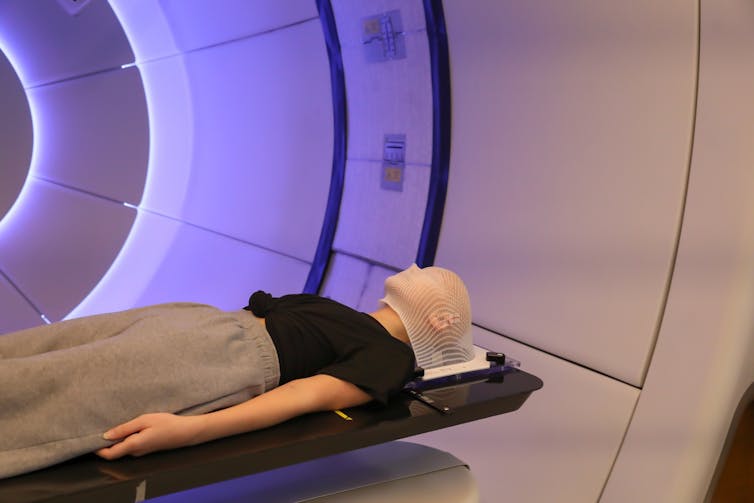Radiation is a targeted form of cancer treatment used for up to half of all patients with cancer. Most radiation treatments are delivered using focused X-rays. Because X-rays travel through tissues, this can lead to extra exposure to radiation for healthy organs and tissue.
Proton beam therapy is a more precise treatment that can better focus radiation on a cancer, reducing the side-effects of treatment. However, proton therapy is not available in Canada. Currently, Canadians do not have easy access to this key cancer treatment.
The benefits of proton therapy are especially important for children, teenagers and young adults with cancer, as they can live a long time when cured of their cancer. For example, medulloblastoma is an aggressive brain cancer seen in young people. This type of cancer is usually treated with radiation to the brain and spine, which has risks for cognitive impairment.
For these patients, proton therapy reduces radiation exposure to other organs, including the brain, as well as to the thyroid, chest, abdomen and pelvis. This leads to better cognitive function and fewer long-term side-effects among patients who receive proton therapy compared to X-ray (photon) treatment.
Derek Tsang
Although proton therapy is more expensive to deliver than photon radiation, studies have shown long-term cost-effectiveness of proton beam therapy for medulloblastoma. In a study of more than 1,000 adults with other types of locally advanced cancer, proton therapy led to fewer unplanned hospitalizations.
Canadian guidelines suggest many other cancers would benefit from proton therapy, including some types of brain, head-and-neck and soft-tissue tumours. In addition, ongoing studies are evaluating proton therapy for other body sites, such as prostate and breast cancer.
At present, Canada is the only G7 nation without a medical proton therapy facility. In contrast, many facilities are available across the continental United States.
Patients in the United Kingdom gained public access to proton therapy in 2018. Australia is building a facility that is expected to open in 2025. Other regions and countries with access to proton therapy include 13 countries in Europe, China, Japan, South Korea, Taiwan, India, Saudi Arabia, Singapore and Thailand.
Canadian patients need to travel for treatment
As cancer doctors, we routinely recommend proton beam therapy for many of our young patients who have curable cancers. Researchers in the U.K. estimate that up to 15 per cent of all patients with curable cancers may benefit from proton therapy. However, without a domestic facility, Canadians who need proton beam therapy must travel out-of-country to receive this medically necessary treatment for their cancer.
Although many provinces will cover the costs of treatment with special application, treatment outside of Canada introduces many barriers to care. These include:
- Delays in review and approval by provincial insurance;
- Lack of funding for travel, hotels or meals in some provinces;
- Not having a Canadian passport or foreign visa;
- Illness after cancer surgery preventing one from leaving the country; and
- Inability to take time away from work due to financial hardship.
Patients who are able to travel out-of-country report high levels of stress and feelings of isolation. Many of these concerns would be reduced with a domestic, Canadian proton therapy facility.
Progress toward Canadian facilities
In 2016, Québec announced a partnership with a private health-care company to build a standalone proton therapy facility in Montréal.

(Shutterstock)
However, there were concerns about the costs of a private-public partnership, as well as the ability of such a facility to care for complex patients, such as sick children with cancer. The favourable financial impact of a provincial proton unit within the public system has been evaluated at the McGill University Health Centre, and the Québec Ministry of Health has shown renewed interest in such an initiative.
It is recognized that the per-patient cost to deliver proton therapy would be less if a Canadian facility were available. In 2022, the Ontario government announced public funding to plan and design a proton therapy facility in Toronto; planning work is ongoing.
Cancer Care Alberta recently released provincial guidelines outlining patients suitable for proton therapy. Concurrently, a charitable group has expressed interest in fundraising for a proton facility in Edmonton.
Canadian doctors and patients eagerly await the day when a cancer patient can receive this advanced treatment without travelling out of country.
Having access to proton therapy would also allow Canadian researchers to collaborate globally in scientific studies. It would prevent Canada from falling behind with state-of-the-art treatments, and allow us to join other nations around the world in being able to offer this key treatment against cancer.
This article was co-authored by Dr. Carol Oliveira. She is a radiation oncologist working at the Cedars Cancer Centre, McGill University Health Centre, in Montréal, Québec.




